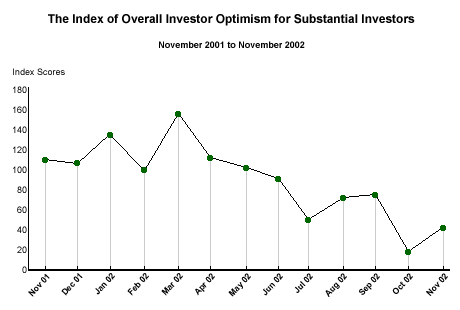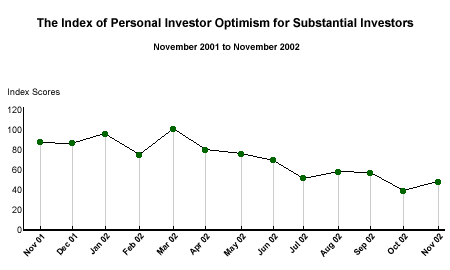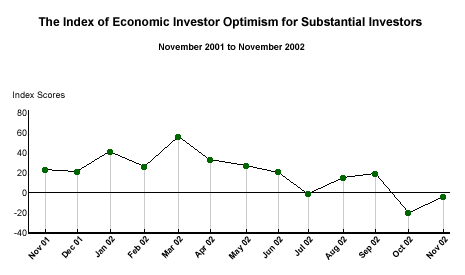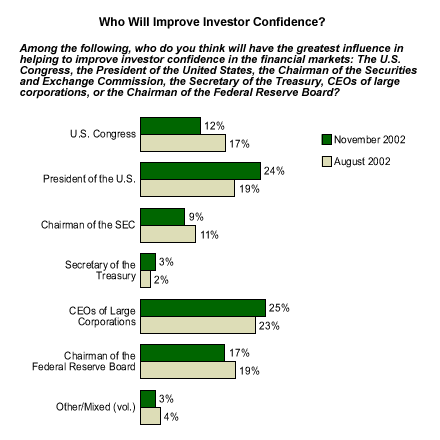Investors have made a great deal of money since the Dow hit a 5-year low in early October. Therefore, it is somewhat surprising that, overall, investor optimism increased only slightly in November, according to the results of the Index of Investor Optimism* -- a joint effort of UBS and The Gallup Organization. The overall Index of Investor Optimism is now at 41, up 12 points from October but also its second-lowest level since its inception in October 1996. (See "Investor Optimism Improves Slightly in November" in Related Items.)
One can only imagine how low investor optimism might have sunk had the equity markets remained at their October lows during November. On the other hand, some on Wall Street suggest that a lack of confidence among average investors is to be expected at this point. In their view, the confidence of investors with substantially more money to invest is currently of much greater importance, because it is they who invest with an eye toward the prospects for the U.S. economy in 2003.
Overall Substantial Investor Optimism Is Weak
Investor optimism also increased among "substantial" investors -- those with $100,000 or more of investable assets -- during November. The overall Index of Investor Optimism for substantial investors increased 24 points to 41 this month. Even with this increase, however, the substantial investor Index is currently at its second-lowest point ever. Substantial investor optimism is also at about half the level it was a year ago (84 in November 2001) and about one-quarter of its March 2002 score (155). Furthermore, the Gallup/UBS investor survey reveals that substantial investors are no more or less optimistic about the current investment climate than are other investors.

The Personal Dimension Is Also Weak
Substantial investor optimism increased along both its Personal and Economic Dimensions in November. The Personal Dimension of the substantial investor Index increased nine points, from 38 in October to 47 in November -- also its next-to-lowest point since the Index began tracking substantial investor optimism in 1996.

The Economic Dimension Is Less Pessimistic
The Economic Dimension of the substantial investor Index increased 16 points from -21 in October to -5 in November. Substantial investors are now somewhat less pessimistic about the near-term outlook for the U.S. economy than they were last month.

Restoring Investor Confidence
Does it matter that substantial investors are no more optimistic than other investors? If you privately asked many of the players on Wall Street, they would tell you that even the perceptions of substantial investors are not really important in the immediate term. Instead, it is the professional money managers who move the markets. And the surging equity markets suggest that these professional investors are much more optimistic about the investment climate outlook for 2003 than are other investors.
Do the professionals know more about the future than the rest of us? Many of them think they do. In fact, they would say that is what they are paid for. But if their optimism about the investment climate outlook is going to be realized, then the confidence of average and substantial investors needs to be restored, and not enough is being done to make this happen. My fear is that many of those who should be acting to restore investor confidence are simply looking at the improving market averages and assuming the crisis is over.
Who should lead the way in restoring investor confidence? One in four American investors (25%) say that the CEOs of large corporations can have the greatest influence in this regard. About the same number (24%) say the same about the president, while 17% point to the chairman of the Fed. Significantly, investors do not view professional money managers as leaders who can restore average investor confidence. Hopefully, the other leaders mentioned are not counting on them to do so.

*Results are based on telephone interviews with 1,001 investors, aged 18 and older, conducted Nov. 1-17, 2002. For results based on the total sample of investors, one can say with 95% confidence that the margin of sampling error is ±3%. For results based on the sample of 400 substantial investors the maximum margin of sampling error is ±5%.

